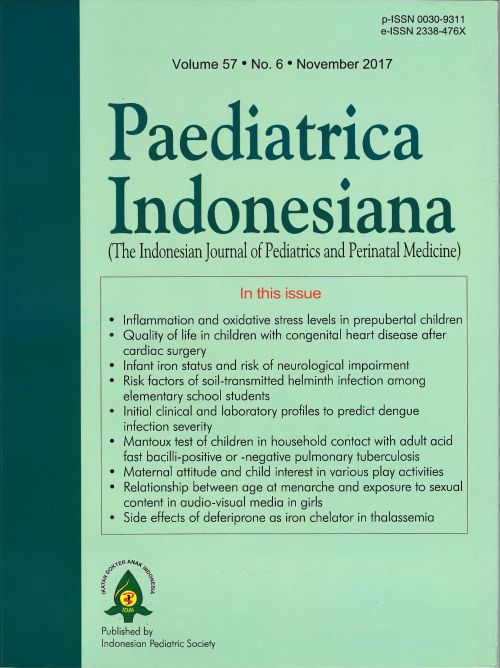Quality of life in children with congenital heart disease after cardiac surgery
DOI:
https://doi.org/10.14238/pi57.6.2017.285-90Keywords:
quality of life, children, cardiac surgery, congenital heart diseaseAbstract
Background Major achievements in congenital heart disease (CHD) treatment over the past 20 years have altered the course and prognosis of CHD. Improvement of quality of life (QoL) is now a major goal of CHD treatment.
Objective To assess the QoL in children after cardiac surgery for CHD.
Methods A cross-sectional study was performed in children aged 2 to 18 years. The case group had 20 children with a history of corrective heart surgery in the 12 months prior to the study. The control group had 20 healthy children, age-matched to the case group. The QoL of both groups was assessed by Pediatric Quality of Life Inventory (PedsQL) Generic Core Scales. The same post-operative children were also assessed with the PedsQL Cardiac Module. Data were analyzed using T-test with P < 0.05 as the level of significance.
Results This study recruited 40 subjects: 20 post-operative and 20 healthy children. PedsQL Generic Core Scales assessment showed significant differences between groups in the physical function parameter of QoL (P<0.05) in children aged 13-18 years, but there were no significant differences in the social, emotional, and school function parameters. In children aged 2-12 years, there were no significant differences in physical, social, emotional, or school parameters. The PedsQL Cardiac Module assessment revealed that 35% of post-operative children was at risk for physical appearance problems, 80% was at risk for anxiety problems, 40% was at risk for cognitive problems, and 80% was at risk for communication problems.
Conclusion Thirteen to 18-year-old children with non complex CHD have poorer physical function than healthy children. Post operative children are at risk for physical appearance, anxiety, cognitive, and communication problems.
References
2. McCrindle BM. Prevalence of congenital cardiac disease. In: Anderson RH, Baker EJ, Penny D, Redington AN, Rigby ML, Wernovsky G, editors. Paediatric cardiology. 3rd ed. Philadelphia: Churchill Livingstone; 2010. p. 143-59.
3. Tahirovic E, Begic H, Tahirovic H, Varni JW. Quality of life in children after cardiac surgery for congenital heart disease. Coll Antropol. 2011;35:1285-90.
4. Tchervenkov CI, Jacobs JP, Bernier P, Stellin G, Kurosawa H, Mavroudis C, et al. The improvement of care for paediatric and congenital cardiac disease across the world: a challenge for the World Society for Pediatric and Congenital Heart Surgery. Cardiol Young. 2008;18:63-9
5. Daliento L, Mapelli D, Volpe B. Measurement of cognitive outcome and quality of life in congenital heart disease. Heart. 2006;92:569-74.
6. Sastroasmoro S, Madiyono B. Penatalaksaan penyakit jantung bawaan. In: Sastroasmoro S, Madiyono B, editors. Buku ajar kardiologi anak. Jakarta: Penerbit IDAI; 1994. p. 87-98.
7. Karamlou TB, Welke TF, Ungerleider RM. Congenital heart disease. In: Brunicardi FC, editor. Schwartz’s principles of surgery. 9th ed. New York: McGrawHill Companies; 2010. p. 591-626.
8. Miatton M, De Wolf D, Francois K, Thiery E, Vingerhoets G. Intellectual, neuropsychological, and behavioral functioning in children with tetralogy of Fallot. J Thorac Cardiovasc Surg. 2007;133:449-55.
9. Landolt MA, Valsangiacomo Buechel ER, Latal B. Health-related quality of life in children and adolescents after open-heart surgery. J Pediatr. 2008;152:349-55.
10. Gierat-Haponiuk K, Haponiuk I, Chojnicki M, Jaworski R, Bakula S. Exercise capacity and the quality of life late after surgical correction of congenital heart defects. Kardiol Pol. 2011;69:810-5.
11. Loup O, von Weissenfluh C, Gahl B, Schwerzmann M, Carrel T, Kadner A. Quality of life of grown-up congenital heart disease patients after congenital cardiac surgery. Eur J Cardiothorac Surg. 2009;36:105-11.
12. Walker WT, Temple IK, Gnanapragasam JP, Goddard JR, Brown EM. Quality of life after repair of tetralogy of Fallot. Cardiol Young. 2002;12:549-53.
13. Varni JW, Burwinkle TM, Seid M. The PedsQL as a pediatric patient-reported outcome: reliability and validity of the PedsQL measurement model in 25,000 children. Expert Rev Pharmacoecon Outcomes Res. 2005;5:705-19.
Downloads
Published
How to Cite
Issue
Section
License
Authors who publish with this journal agree to the following terms:
Authors retain copyright and grant the journal right of first publication with the work simultaneously licensed under a Creative Commons Attribution License that allows others to share the work with an acknowledgement of the work's authorship and initial publication in this journal.
Authors are able to enter into separate, additional contractual arrangements for the non-exclusive distribution of the journal's published version of the work (e.g., post it to an institutional repository or publish it in a book), with an acknowledgement of its initial publication in this journal.
Accepted 2017-12-15
Published 2018-01-05


















